#black abolitionists
Text
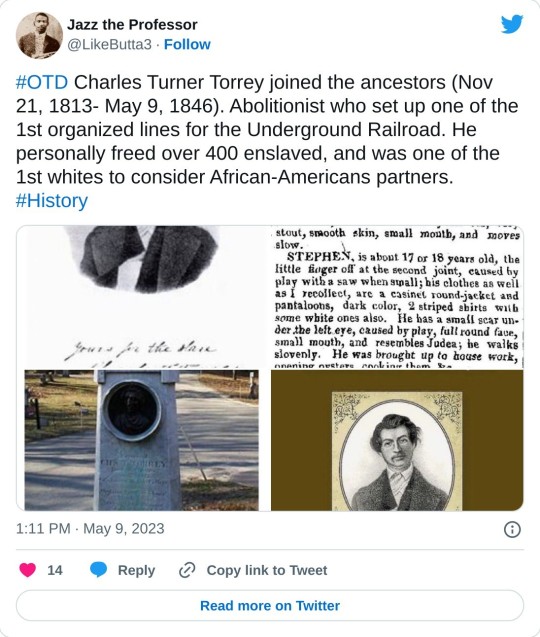
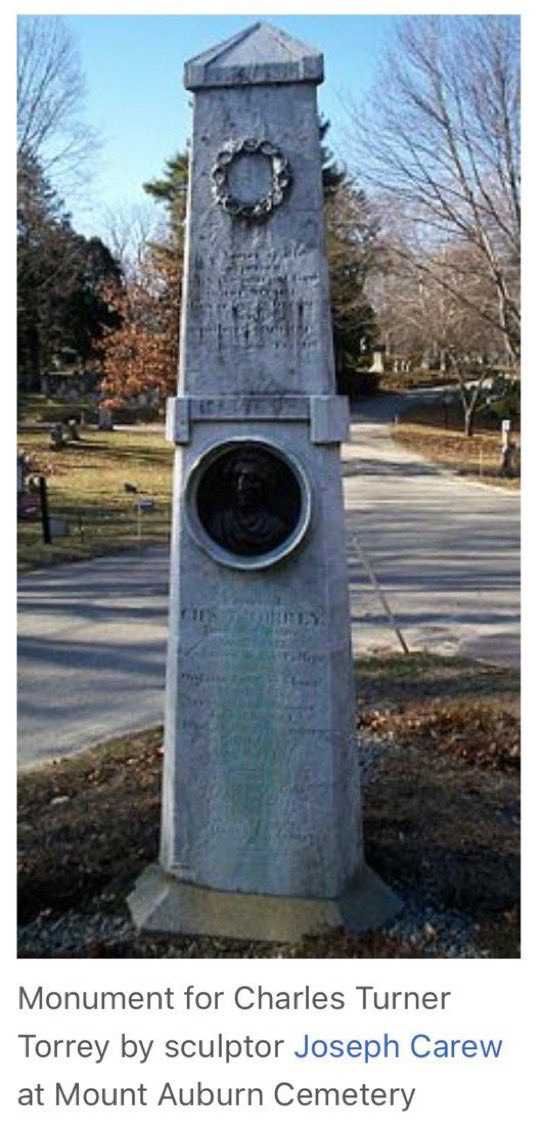

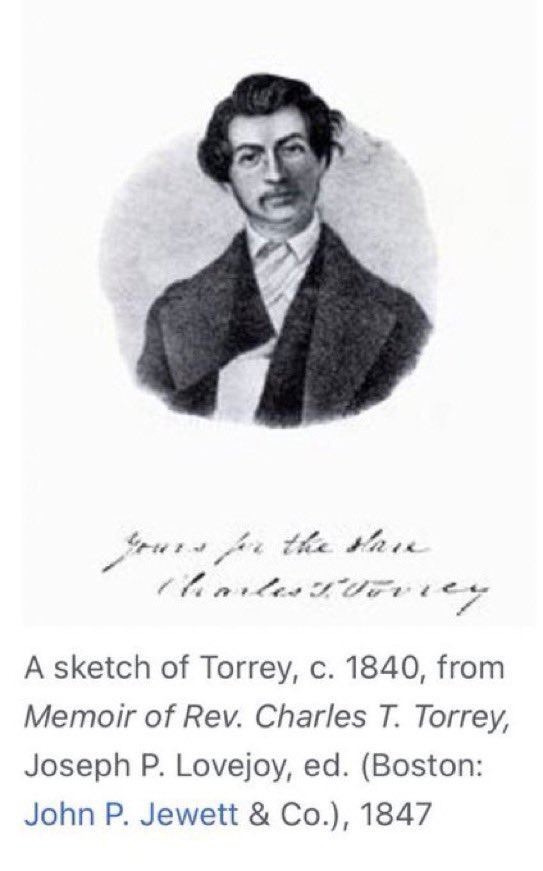

#Charles Torrey#Black Abolitionists#white supremacy#american enslavement of Africans#american history#underground railroad
1 note
·
View note
Text

This was her FAVORITE time of year... She should be spending it with family... she should be be alive. I'm pissed she's not. I'm so so pissed. I'm hurt. on the verge of tears.
Please dont forget her face, her name, her smile, her caring soul.
She wanted to be a nurse. Wanted to help mothers and babies... And she never got to.
The world was a better place when she was in it...
Merry Christmas Breonna... Thinkin ab you...
#justice for breonna#breonna taylor#say her name#abolish the police#abolish capitalism#abolitionist#black lives fucking matter#protect black women#protect black girls#remember her always#merry christmas breonna#thinking ab her heavy today
3K notes
·
View notes
Text
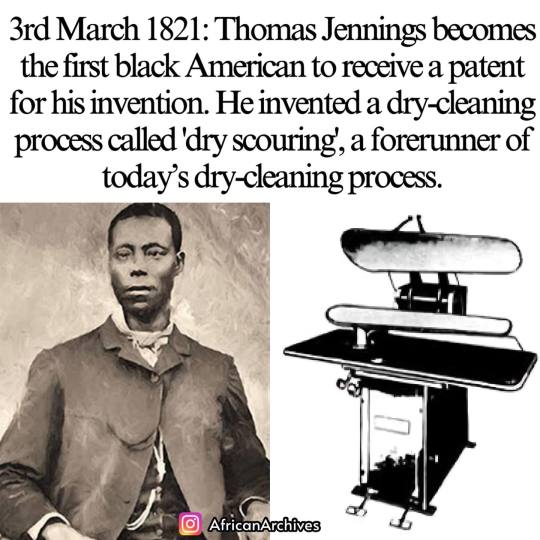
Thomas Jennings was a free man born in 1791 in New York City. He was 30 years old when he was granted a patent for a dry cleaning process. In his early 20s Thomas Jennings became a tailor, and later opened a dry cleaning business in the city. As a tailor. Jennings' skills were so admired that people near and far came to him to alter or custom tailor items of clothing for them. Eventually, Jennings reputation grew such that he was able to open his own store on Church street which grew into one of the largest clothing stores in New York City.
While running his business Jennings developed dry-scouring. He had many customers complain of their clothes being ruined by stains and so he began experimenting with cleaners and mixtures that would remove the stains without harming the material. He earned a large amount of money as a tailor and even more with his dry scouring invention and most of the money he earned went to his abolitionist activities. In 1831, Thomas Jennings became assistant secretary for the First Annual Convention of the People of Color in Philadelphia, PA.
Thomas L. Jennings Dry Scouring technique created modern day dry cleaning. Jennings was fortunate that he was a free man at the time of his invention. Besides all the other indignities and cruelties slaves had to face, they were also ineligible to hold a patent. Under the US patent laws of 1793 a person must sign an oath or declaration stating that they were a citizen of the USA. While there were, apparently, provisions through which a slave could enjoy patent protection, the ability of a slave to seek out, receive and defend a patent was unlikely. Later, in 1858, the patent office changed the laws, stating that since slaves were not citizens, they could not hold a patent. Furthermore, the court said that the slave owner, not being the true inventor could not apply for a patent either.
Thomas Jennings died in New York City in 1856.
#black history#Thomas Jennings#dry cleaning#inventor#tailor#abolitionist#New York City#patent law#slavery#abolitionist activities#dry scouring technique#historical injustice#patent discrimination#civil rights activism#African American entrepreneurship#19th century America
422 notes
·
View notes
Text
I put on batman begins in the background while writing tonight and as Bruce is checking out the cave under Wayne mansion, Alfred goes "your great-great-grandfather used to transport freed slaves to the north using these caverns"
WHAT DO YOU MEAN THE BATCAVE WAS PART OF THE UNDERGROUND RAILROAD
#I've seen this movie at least three times why do I not remember this part at all????#kudos to them for letting everyone know the waynes were abolitionists. happy black history month to me I guess#this elicited a reaction in me not far off from percy jackson dropping that harriet tubman was a demigod#I know. I KNOW. that it's a part of history and that it will be referenced in fictional media. I get it#but 'the batcave was part of the underground railroad' is definitely a sentence I can say. why did they put that in there#sorry this genuinely just took me out of my writing grind and I had to call it a night I was giggling so much#mjspeaks
33 notes
·
View notes
Text
Signal boost for any folks in the Santa Barbara area who might be interested.

#Black Trans Futures#carcerality and abolition#Miss Major Griffin-Gracy#Lavelle Ridley#Toshio Meronek#Eric Stanley#Abolitionist Black Trans events#Black History Month
24 notes
·
View notes
Text
[D]omesticated attack dogs [...] hunted those who defied the profitable Caribbean sugar regimes and North America’s later Cotton Kingdom, [...] enforced plantation regimens [...], and closed off fugitive landscapes with acute adaptability to the varied [...] terrains of sugar, cotton, coffee or tobacco plantations that they patrolled. [...] [I]n the Age of Revolutions the Cuban bloodhound spread across imperial boundaries to protect white power and suppress black ambitions in Haiti and Jamaica. [...] [Then] dog violence in the Caribbean spurred planters in the American South to import and breed slave dogs [...].
---
Spanish landowners often used dogs to execute indigenous labourers simply for disobedience. [...] Bartolomé de las Casas [...] documented attacks against Taino populations, telling of Spaniards who ‘hunted them with their hounds [...]. These dogs shed much human blood’. Many later abolitionists made comparisons with these brutal [Spanish] precedents to criticize canine violence against slaves on these same Caribbean islands. [...] Spanish officials in Santo Domingo were licensing packs of dogs to comb the forests for [...] fugitives [...]. Dogs in Panama, for instance, tracked, attacked, captured and publicly executed maroons. [...] In the 1650s [...] [o]ne [English] observer noted, ‘There is nothing in [Barbados] so useful as … Liam Hounds, to find out these Thieves’. The term ‘liam’ likely came from the French limier, meaning ‘bloodhound’. [...] In 1659 English planters in Jamaica ‘procured some blood-hounds, and hunted these blacks like wild-beasts’ [...]. By the mid eighteenth century, French planters in Martinique were also relying upon dogs to hunt fugitive slaves. [...] In French Saint-Domingue [Haiti] dogs were used against the maroon Macandal [...] and he was burned alive in 1758. [...]
Although slave hounds existed throughout the Caribbean, it was common knowledge that Cuba bred and trained the best attack dogs, and when insurrections began to challenge plantocratic interests across the Americas, two rival empires, Britain and France, begged Spain to sell these notorious Cuban bloodhounds to suppress black ambitions and protect shared white power. [...] [I]n the 1790s and early 1800s [...] [i]n the Age of Revolutions a new canine breed gained widespread popularity in suppressing black populations across the Caribbean and eventually North America. Slave hounds were usually descended from more typical mastiffs or bloodhounds [...].
---
Spanish and Cuban slave hunters not only bred the Cuban bloodhound, but were midwives to an era of international anti-black co-ordination as the breed’s reputation spread rapidly among enslavers during the seven decades between the beginning of the Haitian Revolution in 1791 and the conclusion of the American Civil War in 1865. [...]
Despite the legends of Spanish cruelty, British officials bought Cuban bloodhounds when unrest erupted in Jamaica in 1795 after learning that Spanish officials in Cuba had recently sent dogs to hunt runaways and the indigenous Miskitos in Central America. [...] The island’s governor, Balcarres, later wrote that ‘Soon after the maroon rebellion broke out’ he had sent representatives ‘to Cuba in order to procure a number of large dogs of the bloodhound breed which are used to hunt down runaway negroes’ [...]. In 1803, during the final independence struggle of the Haitian Revolution, Cuban breeders again sold hundreds of hounds to the French to aid their fight against the black revolutionaries. [...] In 1819 Henri Christophe, a later leader of Haiti, told Tsar Alexander that hounds were a hallmark of French cruelty. [...]
---
The most extensively documented deployment of slave hounds [...] occurred in the antebellum American South and built upon Caribbean foundations. [...] The use of dogs increased during that decade [1830s], especially with the Second Seminole War in Florida (1835–42). The first recorded sale of Cuban dogs into the United States came with this conflict, when the US military apparently purchased three such dogs for $151.72 each [...]. [F]ierce bloodhounds reputed to be from Cuba appeared in the Mississippi valley as early as 1841 [...].
The importation of these dogs changed the business of slave catching in the region, as their deployment and reputation grew rapidly throughout the 1840s and, as in Cuba, specialized dog handlers became professionalized. Newspapers advertised slave hunters who claimed to possess the ‘Finest dogs for catching negroes’ [...]. [S]lave hunting intensified [from the 1840s until the Civil War] [...]. Indeed, tactics in the American South closely mirrored those of their Cuban predecessors as local slave catchers became suppliers of biopower indispensable to slavery’s profitability. [...] [P]rice [...] was left largely to the discretion of slave hunters, who, ‘Charging by the day and mile [...] could earn what was for them a sizeable amount - ten to fifty dollars [...]'. William Craft added that the ‘business’ of slave catching was ‘openly carried on, assisted by advertisements’. [...] The Louisiana slave owner [B.B.] portrayed his own pursuits as if he were hunting wild game [...]. The relationship between trackers and slaves became intricately systematized [...]. The short-lived republic of Texas (1836–46) even enacted specific compensation and laws for slave trackers, provisions that persisted after annexation by the United States.
---
All text above by: Tyler D. Parry and Charlton W. Yingling. "Slave Hounds and Abolition in the Americas". Past & Present Volume 246, Issue 1, pages 69-108. February 2020. [Bold emphasis and some paragraph breaks/contractions added by me.]
#abolition#its first of february#while already extensive doumentation of dogs in american south in 1840s to 60s#a nice aspect of this article is focuses on two things#one being significance of shared crossborder collaboartion cooperation of the major empires and states#as in imperial divisions set aside by spain britain france and us and extent to which they#collectively helped each other crush black resistance#and then two the authors also focus on agency and significance of black resistance#not really reflected in these excerpts but article goes in depth on black collaboration#in newspapers and fugitive assistance and public discourse in mexico haiti us canada#good references to transcripts and articles at the time where exslaves and abolitionists#used the brutality of dog attacks to turn public perception in their favor#another thing is article includes direct quotes from government and colonial officials casually ordering attacks#which emphasizes clearly that they knew exactly what they were doing
21 notes
·
View notes
Text
"What does he know of the half-starved wreaths toiling from dawn till dark on the plantations? of mothers shrieking for their children, torn from their arms by slave traders? of young girls dragged down into moral filth? of pools of blood around the whipping post? of hounds trained to tear human flesh? of men screwed into cotton gins to die?"
Harriet Jacobs, Incidents in the Life of a Slave Girl
#incidents in the life of a slave girl#harriet jacobs#slavery#american slavery#abolition of slavery#abolitionist#liberation#liberty#freedom#racism#racism in america#human rights violations#human rights abuses#poc#black academia#black feminism#black liberation#american authors#american literature#literature#literature quotes#race theory#race and gender#race and ethnicity
13 notes
·
View notes
Text
On this day in 1886: Black abolitionist shares Underground Railroad strategy ⋆ Michigan Advance
On Jan. 17, 1886, Black abolitionist William Lambert revealed that he was part of a secret order called, “African American Mysteries: Order of the Men of Oppression.” He made the declaration in a Detroit Tribune newspaper article.
Lambert and others used codes, passwords and secret handshakes to help slaves gain freedom along the Underground Railroad, the Detroit tailor said.
“These and other abolitionist efforts, by both groups and individuals, assisted thousands of fugitives on their travels on the Underground Railroad in Michigan,” according to the Detroit Historical Society. William Lambert | Burton Historical Collection, Detroit Public Library
The “railroad” was a multi-state network of men and women, Blacks and whites African American who offered shelter and aid to escaped enslaved people from Southern states like Kentucky, Alabama, Georgia and Mississippi.
President Abraham Lincoln issued the Emancipation Proclamation on Jan. 1, 1863, ending slavery in America.
Born in Trenton, N.J, Lambert was 21 when he arrived in Detroit in 1838. As a leader in the Underground Railroad movement, Lambert assisted in the escapes of Thornton and Rutha Blackburn in 1833. They were slaves from Kentucky.
In 1837, Lambert helped to form the Detroit Anti-Slavery Society. It included prominent Black abolitionists Robert Banks, and Madison Lightfoot as well as prominent whites Edwin Cowles, Robert Steward and Shubael Conant.
In 1840, Lambert addressed the Michigan Legislature and challenged the body to amend the state constitution to allow for African Americans to be given full citizenship.
Three years later, Lambert also participated in a two-day Negro Suffrage Convention which was held at Second Baptist Church, Michigan’s first Black church congregation located in Detroit. There, 23 delegates discussed and planned a strategy to win voting rights and sustainable employment for African Americans.
A resolution adopted by the assembly read as follows:
“Whereas we find ourselves existing in this state, with no marks of criminality attached to our names as a class — no spots of disloyalty dishonoring our birthright; and whereas, we yet find ourselves the subjects and not the objects of legislation, because we are prevented from giving an assenting or opposing voice in the periodic appointments of those who rule us.”
Lambert died in 1890 at age 71.
#Detroit#African Mysteries#African American Mysteries#Black Revolutionaries#On this day in 1886: Black abolitionist shares Underground Railroad strategy#William Lambert
10 notes
·
View notes
Text

Art and gardening has taken me on several paths in my life and it always leads to community. This is from a group exhibition in 2021.
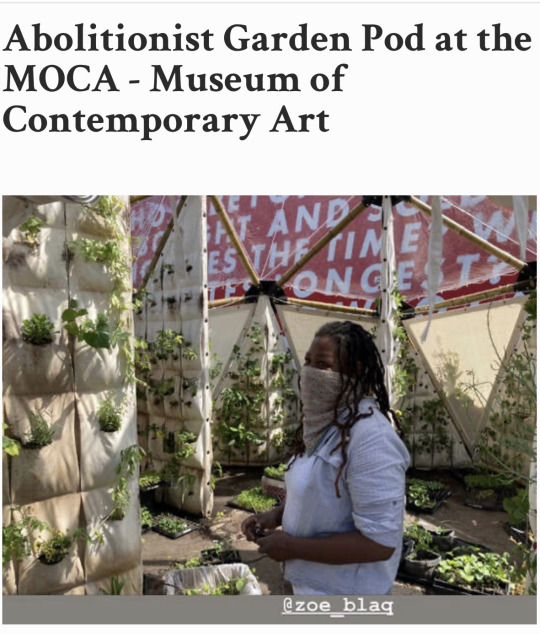
#contemporaryart#ecoart#MOCA#black artist#urbansoulfarmer#urban gardening in los angeles#abolitionist
22 notes
·
View notes
Text
if you want to be involved with prison and police abolition, I think it's absolutely essential that you stretch your imagination to what you're going to build, then think of what has to be destroyed in order for you to do that. Like if I'm reaching out my hand to form a bond with someone and weave them into my life and myself into theirs, I want to break down everything that gets in the way of that. In order to be good comrades to prisoners, to Black people, to disabled people, to indigenous people, to queer and trans people, to poor people, we must figure out how to live in a world without police and prisons. You'll never get rid of these things if you aren't first striving to be a good (and honestly loving!) comrade. The love has to come first!
#was talking to a friend about this last night#i think the thing that keeps me from identifying as an anarchist or a communist outright is that abolition is so primary to my sense of the#world and what must be done#i think both communism and anarchism have much to learn from the Black abolitionist struggle#there is no kinder prison or cop under anarchy or communism. there should just be no prisons or cops.#abolition
30 notes
·
View notes
Text
"Black women have the most abortions-"
Alright listen good, you dense fuck. Due to the origin of gynecology and the Tuskegee syphilis experiment, black people have a hard time trusting medicine. It's a long-running myth among black women that birth control causes infertility or can kill you, so more white women than black women take birth control. Christianity also has a chokehold on black people so combine a stigma around birth control with the pronatalism of Christianity and you get a shit ton of unplanned pregnancies + teen motherhood. So this leaves black women 2 main options: become a mother of 4+ kids by age 25 or get the abortion cuz your education on contraception was spotty. Kindly stop using black women as a fucking prop for your shitty forced birth nonsense
#feminism#feminine rant#prolife#abortion#abortion abolitionists#christian#catholicism#black women#black people#prochoice#pro choice#womens rights#anti religion#prolifer#forced birth#right to life#pro life#reproductive rights#abortion is healthcare#bodily autonomy
9 notes
·
View notes
Text

Seriously, people who complain about any vaguely liberal idea as socialist have no idea how many of the rights they like and take for granted were won by socialists, abolitionists, suffragettes, black liberationists, and other radicals.
#politics#us politics#progressive#socialism#socialist#radicalism#radical#labor rights#worker rights#working class#conservativism#black power#black liberation#women's suffrage#abolitionist
10 notes
·
View notes
Text

Malcolm X and Frederick Douglass.
Happy Black History Month 🖤
#malcolm x#frederick douglass#black history#black history month#black history matters#black history is american history#black artists#african american art#ajuan mance#black men#black art#black artists on tumblr#black power#african american#civil rights movement#abolitionist
4 notes
·
View notes
Text
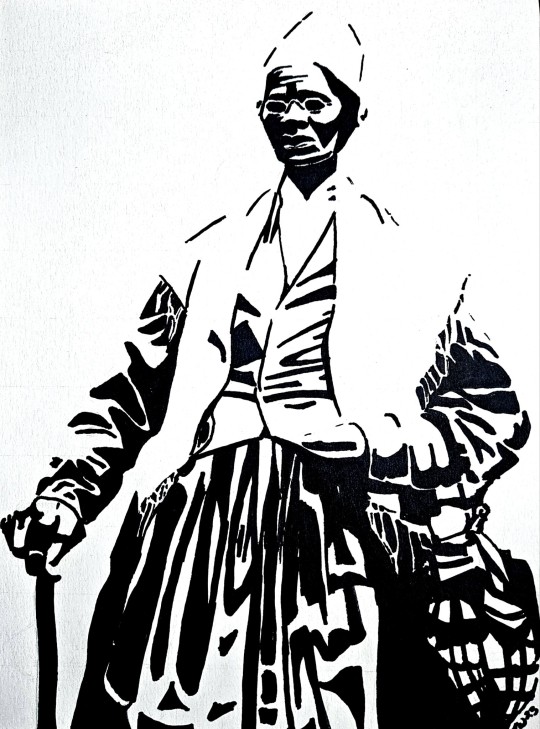
Happy Black History Month!
A commission of Sojourner Truth I did for a friend.
Sharpie on Bristol board
Commissions are open.
#my art#traditional art#sharpie art#traditional drawing#sojourner truth#american history#abolitionist#black history#black history month#artists on tumblr#female artists#high contrast#pop art#black power#black lives matter#blm#badass women
4 notes
·
View notes
Text
Sarah Parker Remond (June 6, 1826 – December 13, 1894) was an American lecturer, activist and abolitionist campaigner.

Born a free woman in the state of Massachusetts, she became an international activist for human rights and women's suffrage. Remond made her first public speech against the institution of slavery when she was 16 years old, and delivered abolitionist speeches throughout the northeastern United States. One of her brothers, Charles Lenox Remond, became known as an orator and they occasionally toured together for their abolitionist lectures.
Eventually becoming an agent of the American Anti-Slavery Society, in 1858 Remond chose to travel to Britain to gather support for the growing abolitionist cause in the United States. While in London, Remond also studied at Bedford College, lecturing during term breaks. During the American Civil War, she appealed for support among the British public for the Union and their blockade of the Confederacy. After the conclusion of the war in favor of the Union, she appealed for funds to support the millions of the newly emancipated freedmen in the American South.
From England, Remond went to Italy in 1867 to pursue medical training in Florence, where she became a physician. She practiced medicine for nearly 20 years in Italy and never returned to the United States, dying in Rome at the age of 68.
Early years
Born in Salem, Massachusetts, Remond was one of the between eight and 11 children of John Remond and Nancy (née Lenox) Remond.[1] Nancy was born in Newton, daughter of Cornelius Lenox, a Revolutionary War veteranwho had fought in the Continental Army, and Susanna Perry.[2] John Remond was a free person of color who immigrated to Massachusetts from the Dutch colony of Curaçao as a 10-year-old child in 1798. John and Nancy married in October 1807, in the African Baptist Church in Boston. In Salem, they built a successful catering, provisioning, and hairdressing business, becoming well-established businesspeople and activists.
The Remonds tried to place their children in a private school, but they were rejected because of their race. When Sarah Remond and her sisters were accepted to a local high school for girls which was not segregated, they were expelled, as the school committee was planning to found a separate school for African-American children. Remond later described the incident as engraved in her heart "like the scarlet letter of Hester."[1] In 1835, the Remond family moved to Newport, Rhode Island, where they hoped to find a less racist environment in which to educate their children. However, the schools refused to accept black students. Instead, some influential African Americans established a private school, where Remond was educated.[1]
In 1841, the Remond family returned to Salem.[1] Sarah Remond continued her education on her own, attending concerts and lectures, and reading widely in books, pamphlets and newspapers borrowed from friends, or purchased from the anti-slavery society of her community, which sold many inexpensive titles.[3] The Remond family also took i
n as boarders students who were attending the local girls' academy, including Charlotte Forten (later Grimké).[4]
Three of Remond's sisters built a business together: Cecilia (married to James Babcock), Maritchie Juan, and Caroline (married to Joseph Putnam),[4] "owned the fashionable Ladies Hair Work Salon" in Salem, as well as the biggest wig factory in the state.[5] Their oldest sister Nancy married James Shearman, an oyster dealer. The Remond brothers were Charles Remond, who became an abolitionist and orator; and John Remond, who married Ruth Rice, one of two women elected to the finance committee of the 1859 New England Colored Citizens' Convention.
Anti-slavery activism and lecturing
Salem in the 1840s was a center of anti-slavery activity, and the whole family was committed to the rising abolitionist movement in the United States. The Remonds' home was a haven for black and white abolitionists, and they hosted many of the movement's leaders, including William Lloyd Garrison and Wendell Phillips, and more than one fugitive slave fleeing north to freedom. John Remond was a life member of the Massachusetts Anti-Slavery Society.[2] Sarah Remond's older brother Charles Lenox Remond was the first black lecturer of the American Anti-Slavery Society's and considered a leading black abolitionist. Nancy Remond was one of the founders of the Salem Female Anti-Slavery Society.[1] Nancy not only taught her daughters the household skills of cooking and sewing but also to seek liberty lawfully; she wanted them to take part in society.[3] With her mother and sisters, Sarah Remond was an active member of the state and county female anti-slavery societies, including the Salem Female Anti-Slavery Society, the New England Anti-Slavery Society, and the Massachusetts Anti-Slavery Society. She also regularly attended antislavery lectures in Salem and Boston.[2]
With the support and financial backing of her family, Sarah Remond became an anti-slavery lecturer, delivering her first lecture against slavery at the age of 16, with her brother Charles in Groton, Massachusetts, in July 1842.[6] Remond rose to prominence among abolitionists in 1853, when she refused to sit in a segregated theater section. She had bought tickets by post for herself and a group of friends, including historian William C. Nell, to the popular opera, Don Pasquale, at the Howard Athenaeum in Boston.[7] When they arrived at the theatre, Remond was shown to segregated seating. After refusing to accept it, she was forced to leave the theatre and pushed down some stairs.[3] Remond sued for damages and won her case. She was awarded $500, and an admission by theatre management that she was wronged; the court ordered the theater to integrate all seating.[7][8]
In 1856, the American Anti-Slavery Society hired a team of lecturers, including Remond; Charles, already well known in the U.S. and Britain; and Susan B. Anthony, to tour New York State addressing anti-slavery issues. Over the next two years, she, her brother, and others also spoke in New York, Massachusetts, Ohio, Michigan and Pennsylvania.[2] She and other African Americans were often given poor accommodation due to racial discrimination.[3] Although inexperienced, Remond rapidly became an effective speaker. William Lloyd Garrison praised her "calm, dignified manner, her winning personal appearance and her earnest appeals to the conscience and the heart."[9] Sarah Clay wrote that Remond's every word "waked up dormant aspirations which would vibrate through the ages."[1] Over time, she became one of the society's most persuasive and powerful lecturers.[10]
Abby Kelley Foster, a noted abolitionist in Massachusetts, encouraged Remond when they toured together in 1857.[11] On December 28, 1858, Remond wrote in a letter to Foster:[12]
I feel almost sure I never should have made the attempt but for the words of encouragement I received from you. Although my heart was in the work, I felt that I was in need of a good English education ... When I consider that the only reason why I did not obtain what I so much desired was because I was the possessor of an unpopular complexion, it adds to my discomfort.
see rest of article
#Sarah Parker Remond#June 6#june 6 1826#Women in history#Black women in history#Black women in the Abolitionist movement#Black women in medicine
9 notes
·
View notes
Text

Harriet Tubman was an American abolitionist and social activist. She was born into chattel slavery but escaped and subsequently made some 13 missions to rescue approximately 70 similarly-enslaved people, including family and friends, using the network of antislavery activists and safe houses known as the Underground Railroad. During the American Civil War, she served as an armed scout and spy for the Union Army. In her later years, Tubman was an activist in the movement for women's suffrage. Harriet died on March 10, 1913 at the age of 91.
#harriet tubman#love#abolitionist#social activist#slavery#civil war#womens suffrage#brave women#underground railroad#courage#freedom#black lives
13 notes
·
View notes